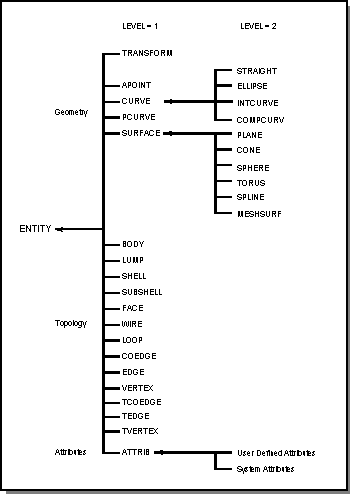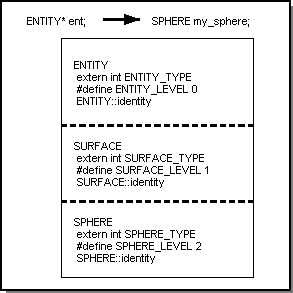Identifying Model Objects
A model object is any object that can be saved to and restored from a save file (.sat or .sab). ACIS model objects are implemented in C++ using a hierarchy of classes derived from the ENTITY class.
This section describes mechanisms for identifying the type of any class derived from ENTITY, as well as its level of derivation.
Topics include:
- Using is_entityclass Functions
- Derivation from ENTITY
- Object Type
- Object Level
- Inquiring the Type of an Object
Using is_entityclass Functions
Applications may use functions named is_<entityclass> (where <entityclass> is the name of a class derived from ENTITY) to determine if a given object is a specific type of entity (that is, a specific class derived from ENTITY). For example the is_ELLIPSE function takes an ENTITY object and returns a logical that indicates if the ENTITY is an ELLIPSE or not.
Derivation from ENTITY
Although the ENTITY class itself does not represent objects within the modeler, any class that represents a permanent model object in ACIS must be derived from ENTITY in order to inherit the common data and functionality that is mandatory in all permanent objects.
An ENTITY pointer can point to an object of class ENTITY, or to an object of any class derived from ENTITY (directly or indirectly). Because it is often necessary to know the specific class of the object (FACE, LUMP, SHELL, SURFACE, STRAIGHT, etc.), functionality is built into these classes to support this determination.
The following figure illustrates the derivation of the classes from ENTITY. The individual classes are described in detail in reference templates in online help.

Figure. Derivation from ENTITY
Object Type
Each ACIS class derived from ENTITY has a type. Each type is assigned a unique constant integer value associated with the class at compile time. No two type variables have the same value.
The actual integer value of a type should never be directly referenced in code, since it may change. Instead, the type's name should be referenced. Types are named <CLASS>_TYPE.
The following table lists the most common classes and type names:
| Class | Type Name | Class | Type Name |
|---|---|---|---|
|
BODY_TYPE |
POINT |
POINT_TYPE |
|
|
LUMP_TYPE |
CURVE_TYPE |
||
|
WIRE_TYPE |
PCURVE_TYPE |
||
|
SHELL_TYPE |
SRUFACE_TYPE |
||
|
SUBSHELL_TYPE |
ELLIPSE_TYPE |
||
|
FACE_TYPE |
STRAIGHT_TYPE |
||
|
LOOP_TYPE |
SPHERE_TYPE |
||
|
COEDGE_TYPE |
CONE_TYPE |
||
|
EDGE_TYPE |
PLANE_TYPE |
||
|
VERTEX_TYPE |
TORUS_TYPE |
||
|
|
|
SPLINE_TYPE |
|
|
TRANSFORM_TYPE |
INTCURVE_TYPE |
||
|
|
|
MESHSURF |
MESHSURF_TYPE |
|
ATTRIB_TYPE |
COMPCURV |
COMPCURVE_TYPE |
Object Level
Each ACIS class derived from ENTITY has a level, which is an integer representing the level of derivation of the class from ENTITY. For example, BODY is directly derived from ENTITY and has a level of 1. SPHERE is derived from SURFACE, which is derived from ENTITY, so SPHERE has a level of 2.
The actual integer value of the level should never directly referenced, since it could change (although this is unlikely). Instead, the level's name should be referenced. Levels for each class are named <CLASS>_LEVEL.
The following table lists the most common classes and their levels of derivation from the ENTITY class:
| Class | Level Name and Value | Class | Level Name and Value |
|---|---|---|---|
| BODY | BODY_LEVEL = 1 |
POINT |
POINT_LEVEL = 1 |
| LUMP | LUMP_LEVEL = 1 | CURVE | CURVE_LEVEL = 1 |
| WIRE | WIRE_LEVEL = 1 | PCURVE | PCURVE_LEVEL = 1 |
| SHELL | SHELL_LEVEL = 1 | SURFACE | SRUFACE_LEVEL = 1 |
| SUBSHELL | SUBSHELL_LEVEL = 1 | ELLIPSE | ELLIPSE_LEVEL = 2 |
| FACE | FACE_LEVEL = 1 | STRAIGHT | STRAIGHT_LEVEL = 2 |
| LOOP | LOOP_LEVEL = 1 | SPHERE | SPHERE_LEVEL = 2 |
| COEDGE | COEDGE_LEVEL = 1 | CONE | CONE_LEVEL = 2 |
| EDGE | EDGE_LEVEL = 1 | PLANE | PLANE_LEVEL = 2 |
| VERTEX | VERTEX_LEVEL = 1 | TORUS | TORUS_LEVEL = 2 |
| SPLINE | SPLINE_LEVEL = 2 | ||
| TRANSFORM | TRANSFORM_LEVEL = 1 | INTCURVE | INTCURVE_LEVEL = 2 |
| MESHSURF | MESHSURF_LEVEL = 2 | ||
| ATTRIB | ATTRIB_LEVEL = 1 | COMPCURV | CO2PCURVE_LEVEL = 1 |
Inquiring the Type of an Object
Each ACIS class derived from ENTITY has an identity method to allow applications and ACIS to inquire the type of an object, given an ENTITY pointer to that object.
The identity method accepts a single integer argument for the derivation level desired and returns an integer specifying the type of the object. The prototype for the identity method is:
| int identity(int level) const; |
The level argument is optional. If no level is specified, the most specific type of the object (greatest level of derivation) is returned.
For example, if an object is defined of a class whose derivation is sphere:SPHERE:SURFACE:ENTITY, and no level is specified, the identity function returns an integer whose value is sphere_TYPE (which corresponds to level=3). If level=2 is specified, SPHERE_TYPE is returned. If level=1 is specified, SURFACE_TYPE is returned. This mechanism, along with the C++ concept of polymorphism, allows a parent class to automatically call child methods where appropriate, and allows application code to determine the exact nature of the object being operated on. Refer to the following figure.

Figure. SPHERE Object
[Top]
© 1989-2007 Spatial Corp., a Dassault Systèmes company. All rights reserved.